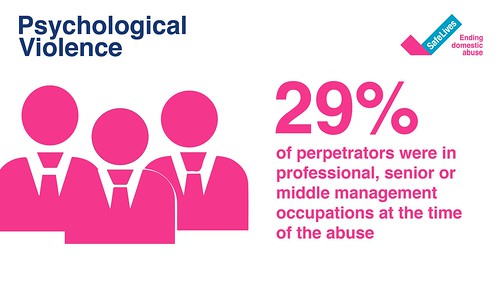Psychological abuse
Psychological abuse involves the regular and deliberate use of a range of words and non-physical actions used with the purpose to manipulate, hurt, weaken or frighten a person mentally and emotionally; and/or distort, confuse or influence a person’s thoughts and actions within their everyday lives, changing their sense of self and harming their wellbeing.
This report was funded by the Oak Foundation to undertake research of ‘psychological violence’ as part of their ‘Issues Affecting Women’ programme. It is co-created with survivors with lived experience and practitioners to shed light on the regularity of psychological abuse, the daily experience of those living with it, and the tactics perpetrators use to threaten and control.
Blog: SafeLives' research into psychological abuse - Jen Daw
Out of those survivors who experienced nonphysical abuse, 91% experienced psychological abuse at some point in the relationship.

Nearly half (49%) of those surveyed experienced psychological abuse regularly.
Practitioners responding to domestic abuse confirmed this regularity – with nearly three-quarters of practitioners saying that psychological violence was ‘always or often’ reported to them when discussing domestic abuse.
Many survivors will experience some form of psychological violence in isolation from physical abuse – 42% had never been physically assaulted causing bruising or cuts and 76% had never been physically assaulted causing broken bones or serious injuries.
Psychological abuse follows a pattern of abuse and manipulation, often involving a phase of ‘grooming’

At the beginning of their relationships, 96% of survivors said their partner was charming and affectionate, 93% said they expressed love for them very quickly and 92% wanted to spend a lot of time together. Abusive behaviour is interspersed with warmth and kindness, slowly desensitising the victim to the behaviour.
Perpetrators use a wide range of hidden tactics to maintain control and brainwash their victim, presenting insults as a joke, gaslighting, and presenting different versions of events.
Nearly half (48%) of survivors reported regularly being told they were mentally unstable, and over half regularly experienced control in who they could speak to, meet socially or spend time with.
Perpetrators take advantage of victims’ vulnerabilities; those with mental health illnesses were threatened with being sectioned, whereas those with precarious immigration status reported citizenship being used to keep them dependent upon their abuser.
Psychological violence is as harmful to victims as physical violence

Victims of psychological violence make up a disproportionate population of psychiatric patients; with links to suicide ideation and suicide attempts.
Practitioners report severe and devastating impacts on victims mental and emotional health, impacting the person’s ability to parent, work, socialise and ability to generally function day-to-day.
Children are hidden victims of psychological abuse, with contact often used as a means to continue control

Children living with psychological abuse are often used as ‘tools of abuse’. 85% of survivors said the perpetrator used the children to threaten and control them and 72% of survivors said the perpetrator attempted to turn their children against them.
There are no ‘typical’ victims or perpetrators of psychological abuse

Previous research finds that of visible cases, women who earn 65% or more of their household income are more likely to be psychologically abused than those who earn less than 65%.1 In line with this, the Psychological Violence report finds that almost a third of perpetrators were in professional, senior or middle management at the time of the abuse, with roles including a police officer, psychologist and director of children’s services.
We must do more to see the whole picture for every adult, child and whole family experiencing any form of domestic abuse. We hope this report is the first step in opening up that conversation, shining a light on psychological abuse and raising awareness and understanding of the tactics used by perpetrators.
1. Kaukinen, C. (2004). Status compatibility, physical violence, and emotional abuse in intimate relationships. Journal of Marriage and Family, 66(2), 452–471.
